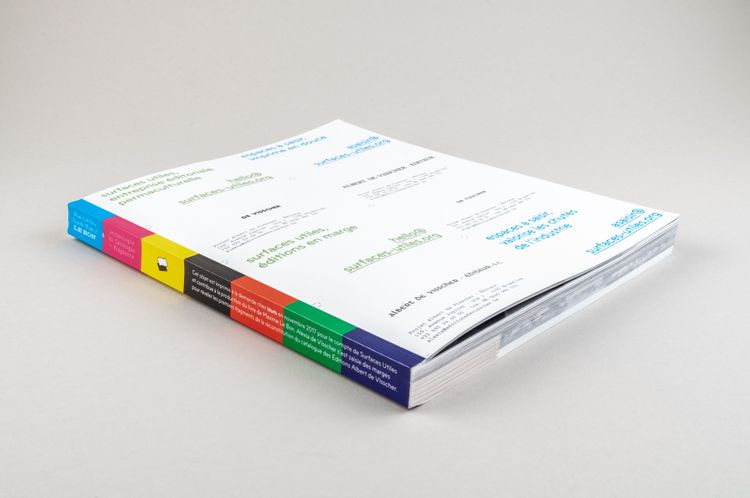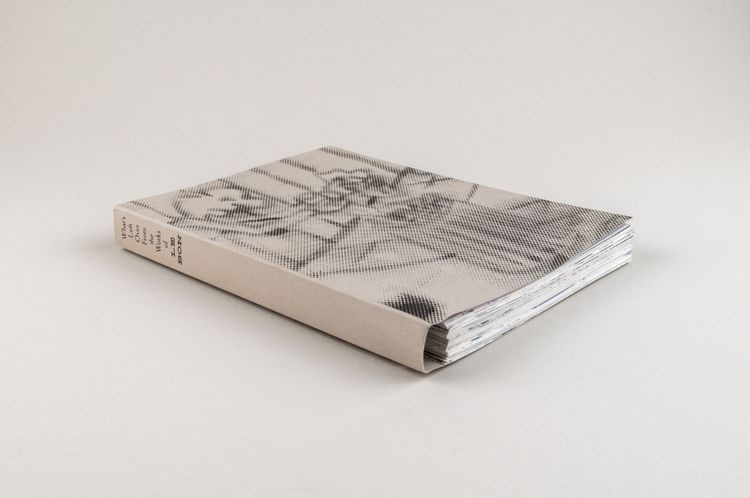Olivier Bertrand has made the production of books in margins the basic principle of his publishing house Surfaces Utiles. Bertrand characterizes his publishing strategy with the French expression “faire la perruque,” borrowed from Michel de Certeau and describing a kind of détournement: what is meant by this is using the working time and the working means, resources, or tools of a company to one’s own advantage, or to the company’s disadvantage.

This volume printed on demand by Blurb is intended as a (financially favorable) intermediate product that will end up in two independent books: Maxime Le Bon’s What’s Left Over From the Works of Le Bon and Alexia de Visscher’s Archeology of the Catalogue – Fragments.
Originally, the publisher Surfaces Utiles worked only on the publication of Le Bon’s drawings. Since the drawing format does not correspond to Blurb’s standard formats, there would have been a lot of unused white space around the drawings. To make the best of this situation, Alexia de Visscher was invited to fill in and design these blank spaces in the margins of the pages to produce her own publication. These inserted fragments are part of her Projet Albert de Visscher – Éditeur, an artistic proposal that questions a family history, an archive, and the practice of publishing.
Each copy reproduces Maxime Le Bon and Alexia de Visscher’s drawings and fragments ten times in digital four-color printing. The laborious production of the digital template, which has to merge and interpose two different works, is outweighed by the optimal use of the paper and format. From the bound books supplied by Blurb, the spine is cut off, the pages are cut into three parts, and these are then reassembled and further processed for the production of Visscher and Le Bon’s books.
The cover, which comes standard with Blurb, is actually an unnecessary accessory for this project. To prevent this from becoming waste either, it was “misused” for the production of business cards. That Surfaces Utiles has released this intermediate product for sale on Blurb helps in understanding the production process.

“The drawings reproduced in this book are A5-format fragments of the work that Maxime Le Bon would bin because he considered them unsatisfactory. Before throwing them away however, the artist keeps what he sees as valuable—painting mistakes, unforeseen jokes, surprising narrative elements—to archive and make into raw material for new work.
It is a coincidence that Surfaces Utiles came across these fragments at the time when many A5-format paper scraps became available. However, the stock was insufficient to complete the entire publication, therefore we had to rely on some ‘tricks’ to manage it anyway. We hijacked the services of a famous printer on demand and found the missing paper without really having to pay for it” (Surfaces Utiles, “what’s left over from the works of le bon”).
The starting point for this edition was the publication What’s Left Over From the Works of Le Bon + Archéologie du Catalogue—Fragments produced in color by Blurb, from which the pages were taken, which were then further processed in several steps into a ring binder. Various printing techniques and providers were used: risoprint (Autobahn) for the black parts, silkscreen (Chromodrome), and at-home inkjet and laser printing. Many pages even went through multiple printings. The print run was 100 copies. For this, ten books were commissioned from Blurb, each of which contained the necessary material ten times.

